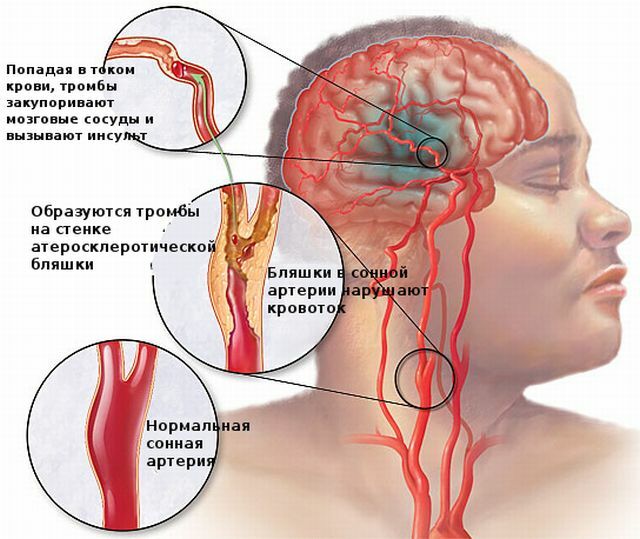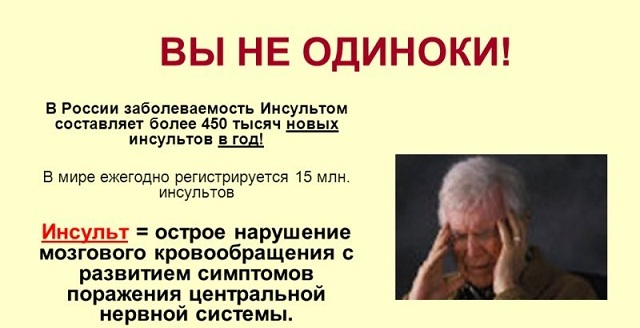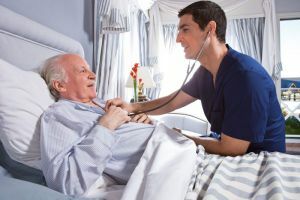Stroke - is poor circulation in the brain, where the blood flow is stopped or is bleeding. Neurons deprived of oxygen die after several minutes.

Be able to identify the symptoms of a stroke and the first signs it is necessary to prevent stroke, which can happen at any age.
Contrary to popular belief, know all about stroke, it is necessary not only deep elders. Brain (cerebral) catastrophe for various reasons found in the young, and even infancy.
Because of what happens
In 2006, the WHO established October 29 Day to Combat stroke. This disease is on the 3rd leading cause of death and on the 1st place as a cause of disability.
The need to know the causes of stroke and how it arises statistics show. In Russia, die from the disease to 175 people per 100,000 population.
Even the correct treatment of stroke is not always a positive effect:
- To work after strike back 10% of the victims.
- Almost 85% of post-stroke patients can not completely take care of themselves.
- Profound disabilities are 25% of the victims.
Among the causes of stroke, WHO identified four categories of factors, combining them on priority.
The main reasons for provoking vascular events include:
- atherosclerosis;
- hypertension;
- migraine;
- diabetes;
- heart disease - myocardial infarction, arrhythmia;
- lack of exercise;
- obesity;
- smoking.
The main causes of stroke of the following - this increased blood pressure (BP) and atherosclerosis.
If blood pressure greater than 160 mm Hg. Art., it increases the risk of cerebral edema and hemorrhage. By increasing the diastolic (relaxation of the heart at the moment) BP 7.5 mm Hg. Art. the risk of stroke is increased in 2 times.

The negative effects of occlusion appear in 75% of the lumen of the blood vessel. Increase in symptoms increases as the diameter of the narrowing of the arteries that carry blood brain neurons.
When a blockage occurs suddenly, ischemic stroke is formed, which becomes the cause abrupt cessation of oxygen delivery in a limited area of the brain.
Cause of ischemic injury may lacunar infarction - poor circulation in a limited area of the white matter of the brain to form in its place afterwards cysts (lacuna).
Among the main risk factors to which the person is able to affect lifestyle changes, WHO has classified:
- alcohol abuse, drug abuse;
- mental disorders;
- Chronic psycho-emotional or physical stress;
- medications - drugs with phenylephrine, codeine;
- social status.
We must also consider the risk factors that can not be influenced, it is:
- floor;
- age;
- heredity.
Most often, vascular brain lesions are found after 65 years, but there is a chance of developing the disease after 40 years.
And in certain vascular diseases, e.g. vascular aneurysms, The impact can catch in 20 years.
Women vessel disease is more common after age 60, and from 18 to 40 years. For men, the probability of pathology higher after 40 years.
In old age, post-stroke survival rate is lower and the number of impacts and their severity higher than in the young.
WHO has classified as at risk:
- hyperhomocysteinemia - the accumulation of homocysteine in the blood, damaging the vessel walls;
- vasculitis - an inflammation of the vascular membranes;
- blood diseases associated with impaired clotting.
Kinds
Distinguish the main types of stroke:
- ischemic;
- hemorrhagic;
- mixed.
Ischemic brain activity account for 90% of all cases of vascular lesions of the brain. They are caused by narrowing of the lumen of the vessel or the cessation of blood flow in the cerebral vessels.
Acute circulatory failure continues for more than 24 hours, causing irreversible necrosis of the brain region (cerebral infarction).

If circulatory failure lasts less than a day, then a condition called transient (transient) ischemic attack (TIA). Symptoms of TIA preceded stroke.
hemorrhagic stroke is a brain hemorrhage caused by the destruction of the vessel wall, or impregnation occurs when blood brain tissue.
The following types of stroke caused by bleeding:
- ventricular - in the ventricle of the brain;
- parenchymal - in brain tissue;
- subarohnaidalny - in the space under the arachnoid;
- the defeat of the cerebellum;
- mixed species.
Depending on the origin, isolated ischemic stroke:
- atherothrombotic;
- lacunar;
- cardiogenic;
- hemodynamic.
The speed of growth of the clinical symptoms of ischemic lesions may be:
- TIA - symptoms appear and disappear completely within 24 hours.
- Minor stroke - when the symptoms appear and disappear within 3 weeks.
- Progressive - symptoms grow for 2-3 days, then the function is partially restored.
- Total - formed cerebral infarction, Neurological deficits created, brain function gradually lost.
Classification of stroke severity:
- Mild - minor symptoms, decreased in the first week of illness.
- Medium gravity - dominated by neurological symptoms, there is no consciousness disorders, cerebral edema.
- Severe form of destruction - there is oppression of consciousness, cerebral disorders.
Hemorrhagic, ischemic strokes and strokes kinds of mixed origin vary the duration of exacerbation of symptoms. Distinguish main stages of the disease:
- Island - the first 3 days;
- acute - the first 30 days;
- early reduction - up to six months;
- late recovery - up to 2 years;
- residual symptoms - after 2 years.
Ischemic stroke
The patient's condition in ischemic stroke worsens gradually. If assistance for "therapeutic window" - the first 2-3 hours after the onset of an attack, it is possible to reduce the effects of vascular accident.

In ischemic lesion neurons die receiving blood from the occluded vessel. Nerve cells in this area remain viable for up to 6 minutes.
Around the lesion is a region of "ischemic penumbra" which the cells experience a lack of oxygen, but they can recover. If for 3 hours to provide patient care, it will be possible to prevent necrosis of the cerebral tissue.
Localization of cerebral infarction focus distinguish types of stroke:
- carotid system - the carotid artery and branches;
- pools cerebral artery;
- vertebrobasilar system - a branch of the vertebral artery;
- cerebellum;
- thalamus.
For the most common varieties of stroke include loss of carotid system. The lesion extends to the frontal, temporal, parietal lobe of the brain, causing impaired speech, writing, reading.
In ischemic or hemorrhagic lesions of the arteries that feed the cerebellum, there is dizziness, nausea, nystagmus - fluctuations in the eyeball.
Thalamic infarction is accompanied by the disappearance of the ability to direct the gaze upwards, Confusion, memory impairment, loss of ability to perceive the world.
hemorrhagic stroke
When hemorrhagic brain disorders, which are caused by bleeding in the brain, the patient is always difficult. It is accompanied by vomiting, loss of consciousness, neck stiffness of muscles.
If the victim asked to bend his head, he could not do it because of the stiffness of neck muscles.
Hemorrhagic kinds of brain strokes occur as a result of:
- high blood pressure;
- break saccular aneurysms - protrusion of the artery walls, filled with blood.
High blood pressure can cause:
- Rupture of blood vessel, wherein the vessel from several minutes blood is poured to form a hematoma.
- Infiltration (impregnation) of the affected blood brain region.
On the mechanism of infiltration having a brain hemorrhage at abusing cocaine, methamphetamine. The probability of rupture of the artery is increased if a person is suffering:
- hemophilia;
- thrombocytopenia;
- intracranial venous thrombosis;
- bundle artery wall;
- Moyamoya syndrome - a disease of the cerebral vessels.
In old age, hemorrhagic shock can be the consequence of amyloid angiopathy - a disease characterized by the deposition of amyloid protein in the capillaries of the brain. The deposition of amyloid plaques is a common cause of cognitive decline after 55 years of stroke in the elderly.
How to identify
Manifestations of the disease developed in the range of from several seconds to several hours. In rare cases, the signs of a stroke a few days intensified.
To recognize a stroke at an early stage, it is necessary to pay attention to a person's behavior, changing his speech, gait.
Symptoms of stroke are typical for all people. When symptoms developing brain disaster should immediately call an ambulance, because the neurons are able to survive without oxygen only 3-6 minutes.
The first signs
Although predict acute brain damage with 100% accuracy is not possible on the appearance of signs of a stroke may indicate:
- sudden weakness;
- the emergence of flies in front of the eyes, blurred vision;
- nausea or vomiting;
- hearing loss, ringing in the head;
- difficulty in speech;
- numbness in half of the face;
- dizziness;
- muscle weakness or muscle rigidity.
The symptoms of an impending stroke do not appear at the same time. The first signs of a stroke are:
- Slurred speech.
- Asymmetrical face smiling turns curve.
- Hand on the losing side does not rise.
If there is at least one of these signs, it means that the cerebral vessels begins a destructive process that can lead to disaster.
WHO proposed to remember the signs of stroke, to perform the test FAST - in the Russian version of BLOW:
- "U" or a smile - to ask the victim to smile.
- "D", or move - to offer to raise both arms.
- "A", or aphasia - speech disorder when trying to name or answer a question.
- "P", or solution - call 112 or call the emergency help.
From others need to fix the time elapsed from the first episode of symptoms that doctors could get a full picture of the state of the victim.
symptomatology
Depending on the localization of the lesion induced by acute stroke, symptoms of stroke is characterized mainly by abnormalities of motor, sensory or cognitive sphere.
Atherothrombotic vascular brain damage happens more often in the elderly, night or early morning. It manifests stroke caused by atherosclerosis, for several hours.

If, after a night of sleep in humans omitted lip area, it slowed down, broken motor coordination, it is necessary, do not hesitate to call the doctor.
Before the stroke can be an attack of atrial fibrillation, psycho-emotional stress or physical stress. Harbinger of circulatory disorders in the brain's blood vessels will be the appearance of a severe headache, noise in the head, confusion.
Progression of brain lesions causes neurological symptoms. The main symptoms of brain stroke are characterized by:
- weakening, blurred vision;
- nausea;
- numbness, weakness of the body, the opposite of the lesions;
- headache;
- dizziness;
- decreased coordination;
- loss of control over the work of the bladder and intestines;
- fainting.
For bleeding under the arachnoid membrane of the brain characterized by severe headaches, an increased risk of coma. The defeat of the frontal lobes is accompanied by a change in personality, appearance of aggression or apathy attacks.
Myocardial temporal lobe accompanied by hearing impairment, occurrence of hallucinations, seizures of epilepsy.
Diagnostics
To diagnose a stroke, it is necessary to carry out the study:
- Blood tests - to check the level of lipids, blood sugar, platelet count and hematocrit.
- CT - computed tomography different types of detailed maps the location and size of the affected area.
- MRI, MR angiography, MR venography make it possible to obtain accurate information about the lesion.
- Cerebral angiogram - a procedure makes it possible to learn more about the patency of the carotid and vertebral arteries.
- Echocardiography - echocardiography is needed to exclude cardiogenic ischemic stroke.
- Ultrasound of the carotid arteries - a study to determine the presence of constrictions of atherosclerotic plaques in blood vessels.
Identify acute brain damage and stroke diagnosis with high accuracy is possible by means of computer diagnostics with contrast - multislice computed tomography (CT).
stroke diagnosis by MSCT also called spiral CT. The method gives more accurate information, allowing you to analyze the tissue of different density: bone, blood vessels, nerves, connective tissue.
First aid
The faster the victim first aid rendered, the less likely that there could be dangerous consequences of stroke. When stroke symptoms immediately call an ambulance.
If a person has normal breathing, and he is conscious, it:
- laid on its side, raising the head;
- provide air access;
- difficulty breathing weaken clothes;
- soothe;
- warm, covered with a blanket;
- do not give anything to drink or eat.
In the absence of consciousness, breathing, pulse and stroke is suspected, do artificial respiration and heart massage should be up to the arrival of doctors.
How to cure
In the first 4 chasa treat brain stroke necessary hospital drugs to lower blood pressure:
- diuretics;
- beta-blockers;
- ACE;
- calcium channel blockers.
In ischemic attack restore blood circulation in the affected area, is prescribed blood thinners.
In hemorrhagic stroke is treated, trying to stop the bleeding.
Blood thinning drugs are contraindicated, since they can increase bleeding.
After the acute period of the patient enters recovery phase. The main treatment after a stroke is performed at home. The recovery period may take several months or even years.
Complex stroke home treatment includes:
- drug therapy to maintain the functionality of the brain;
- thrombosis prophylaxis;
- the prevention of pneumonia in the bedridden and debilitated patients;
- prevention of pressure sores;
- reducing the risk of urinary tract infections.
To improve cerebral circulation patient appointed neuroprotective drugs:
- nootropics;
- antioxidants;
- antihypoxants;
- cardiovascular agents;
- adaptogens.
For the prevention of pneumonia and bedsores it is recommended for improving the well-being to move more independently perform feasible gymnastic exercises and breathing exercises.
In partial paresis of limbs suffered foot or brush is recommended to develop, doing exercises.
If the patient is unable to move independently, shows passive gymnastics. It can be done several times a day, focusing on the patient's condition.

In case of violation of speech to the patient must be addressed with a speech therapist. To speed up the recovery process, with the victims often need to communicate, read and discuss the reading.
Consequences and outlook
Prognosis of the disease depends on the severity of cerebral vessels, presence of concomitant diseases patient care and quality occurred after cerebral accident.
Blow can cause a violation of any of the basic functions of the brain:
- motor activity;
- tactile sensitivity;
- mental performance - memory, logic, language, ability to write, read;
- swallowing;
- orientation in space;
- control of the pelvic organs;
- control over the emotional and volitional.
The consequences of the defeat of the right hemisphere of the brain appear:
- paralysis, muscle weakness, sensory loss in the left side of the body;
- the disappearance of the left-hand sides in the field of view of the eye;
- inability to recognize parts of the body;
- violation of spatial orientation;
- memory impairment;
- impulsive behavior.
If the left hemisphere is damaged, then arise:
- right-sided paralysis, muscle weakness;
- problems with speech, decreased intelligence, mathematics problems;
- violation of the visual apparatus;
- deterioration in the ability to read, learn.
cerebellar stroke It can lead to loss of ability to walk, to maintain balance. The patient has frequent dizziness, headaches, nausea.
With the defeat of the medulla oblongata are affected vital functions. The patient loses the ability to chew, swallow, see, keep balance in space. If affected by the respiratory center, the victim may die.
If insufficient care develop complications that increase the risk of death. Dangerous complications of stroke include pneumonia, urosepsis, bedsores.

The highest mortality from atherothrombotic stroke and cause heart disease. These types of acute cerebral diseases die in the first month to 25% of patients.
Among the survivors up to 75% of patients are unable to work. Prognosis of ischemic stroke better than hemorrhagic.
The lowest probability of death in patients undergoing lacunar stroke. It is only 2%.
prevention
Treatment after stroke at home the conditions need to be complemented by prevention of brain disorders. stroke Prevention Brain aims to eliminate the risk factors of which the most dangerous:
- smoking;
- hypertension;
- diabetes;
- obesity;
- heart diseases.
To avoid a stroke, you need to reduce weight. Losing weight by 5-10 kg allows significantly lower blood pressure and reduce the risk of vascular lesions.
At 5 times higher than normal risk of cerebral vascular pathology in patients diagnosed with atrial fibrillation. If you monitor the status of the heart, it is possible to prevent the occurrence of acute brain damage.
Prevention is not smoking, a gradual increase in physical activity. Daily walks for 30 minutes or gymnastics can help prevent re-apoplectic fit at any age.
To prevent stroke should maintain blood pressure within 135/85. To normalize the indicators in the diet should reduce the amount of salt to eliminate fatty foods, eat fruits and vegetables daily.



